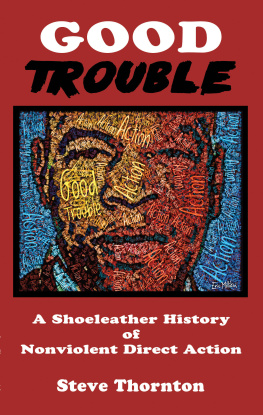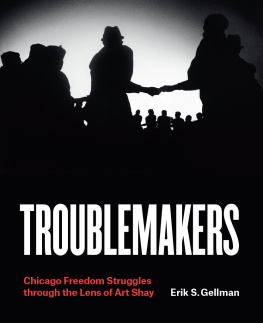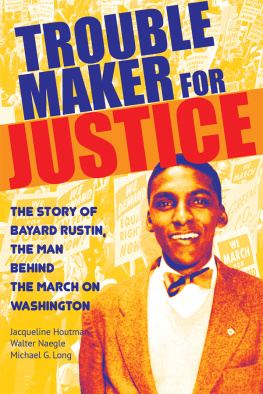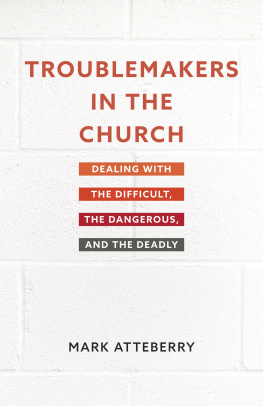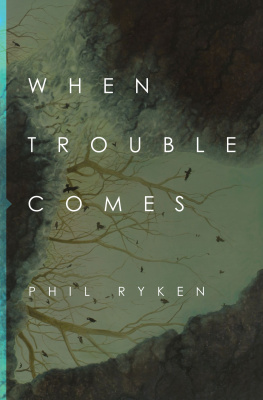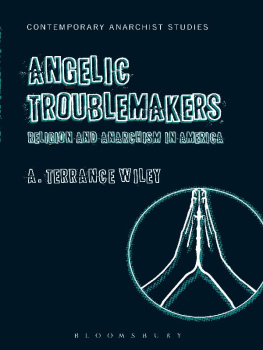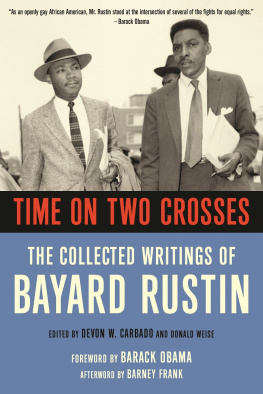Good Trouble
A Shoeleather History of Nonviolent Direct Action
by
Steve Thornton
Table of Contents
Landmarks
Copyright 2019 by Steve Thornton. All rights reserved.
Library of Congress Cataloging-in-Publication Data: Thornton, Steve
Good Trouble, A Shoeleather History of Nonviolent Direct Action
The information in this book is true and complete to the best of our knowledge. It is offered without guarantee on the part of the author or Hardball Press. The author and Hardball Press disclaim all liability in connection with the use of this book.
No part of this book may be reproduced or transmitted in any form or by an electronic or mechanical means, including photocopying, recording or by any information storage and retrieval system, without the express written permission of the publisher, except where permitted by law (fair use).
On the cover: John Lewis: Good Trouble by Eric Millikin Cover & book design by D. Bass
Set in Palatino Lino.
Published by Hard Ball Press, Brooklyn, New York ISBN: 978-1-7328088-7-4
www.hardballpress.com
For Matt, Megan, Pepper, and Kate
Introduction
Direct action is when ordinary people ignore the No Trespassing sign and intervene directly on the stage of history. Small acts, when multiplied by millions of people, can transform the world. -- Howard Zinn
Heres the thing: nonviolent direct action and civil disobedience are frequently dismissed in activist circles as ineffective, or purely symbolic. Not a significant strategy for progressive social change. Over the course of past century, however, people in the city of Hartford, Connecticut have disproved this faulty analysis time and time again.
There is nothing wrong with symbolism, of course. Symbols have power. But ineffective action is a waste of our precious individual and collective energy; the challenge is to create potent tools for social change.
Another criticism of militant nonviolence is that only middle class white people can afford to use it. The stories in this book, however, demonstrate how nonviolent action has consistently been embraced by the citys working class African American and Puerto Rican communities.
As Alicia Garza, co-founder of Black Lives Matter, has written: Every successful social movement in the countrys history has used disruption as a strategy to fight for social change.
Defining the term
That is why the stories in this collection are so important. In every case, these people power actions are undertaken by ordinary folks to make real changes in their lives. And they have. The results have been concrete, practical, and effective. They have contributed to local, national, and even international campaigns for economic, social, and racial justice.
Mass civil resistance actions are often illegal, but not always. In many cases the activists were well versed in nonviolence principles; other times they were completely spontaneous. (I recommend that if you plan to engage in such acts, find an experienced nonviolence trainer to help you prepare.) They came together to act, despite repercussions, because they found the official channels to be impotent, or worse, a trap.
For the purposes of this book, I define nonviolent direct action as a technique of struggle outside of institutional methods (laws, courts, petitions, voting) without the use of injurious force or threat to others. It is open and direct conflict that exposes oppression. It uses a set of special tactics that do not necessarily exclude coercion or property destruction. It is protest, resistance, or intervention to stop injustice and/or to win control over aspects of the political and economic life of our society.
The sociologists Frances Fox Piven and Richard
Cloward wrote that the poor have few resources for regular political influence. Their ability to create social change depends on the disruptive power of tactics such as militant boycotts, sit-ins, traffic tie-ups, and rent strikes. Protest movements, they explained, gain real leverage by causing commotion among bureaucrats, excitement in the media, dismay among influential segments of the community, and strain for political leaders.
Principles of Nonviolent Direct Action
Nonviolent direct action can be a very versatile tool in your organizing tool box. Here is a brief list of its practical applications. As you read the stories in this book, you will find that they fit one or more of these categories. Nonviolent direct action can:
-Directly stop an injustice;
-Assert or defend a positive right despite the consequences;
-Show willful refusal to cooperate with or participate in an injustice;
-Sound the alarm and alert folks to a problem;
-Amplify peoples voices;
-Create a community-based solution.
The use of direct action shouldnt be seen as a one off. It should be grounded in a vision, with goals, a strategy, and tactics. It can be part of an effective campaign that grows bigger, escalates, gains power, and wins.
Of course, not every use of nonviolence produces an instant victory, despite what you find in these pages. You can think of it as an essential component of movement-building.
When you and your cohorts engage in nonviolent direct action, you are likely to feel stronger and more self-confident, more autonomous, and less afraid. The bystanders who witness your action are also affected by it, even if it only makes them angry. When other people see you taking risks, it makes them ask Why?
As Dr. King wrote in Letter from a Birmingham Jail: Nonviolent direct action seeks to create such a crisis and foster such a tension that a community which has constantly refused to negotiate is forced to confront the issue.
The stories here are categorized by topic, and within the topics, by chronology. At the end is a list of books and websites that provide much more information about people power.
I have also included a list of some books that attempt to discredit nonviolent direct action, so the reader can further explore the disagreements that have arisen over the years. Keep in mind that when the violence vs. nonviolence argument comes up, it can be an awful drain on your energy, more heat than light. A better topic to explore might be non-violence vs. non-action.
You will notice that every story is written in the present tense. Thats my attempt to bring these courageous acts to life, out from the dim past.
John Lewis, legendary civil rights organizer, led an unprecedented sit-in on the floor of the House of Representatives on June 22, 2016. Dr. King and Rosa Parks inspired me to get in trouble. Good trouble, the veteran activist explained.
It is in the spirit of John Lewis, and of so many others from different eras, that this book is dedicated.
Steve Thornton 2019
Community/Neighborhood
River of Tears
May 14, 1969
Two young Hartford boys drown in the Park River in 1968. A parent group forms to demand that the rivers depth be lowered to 1.5 feet. Now, a year later, the river is still 6 to 8 feet deep. Seven children have died here since the 1940s. We have decided to get militant, says a protester. The parents are joined by local Black Panthers and several school teachers.
The parents are joined by local school teachers and the Black Panthers, including Butch Lewis, a Vietnam veteran who is under constant surveillance by the Federal Bureau of Investigation (FBI).

